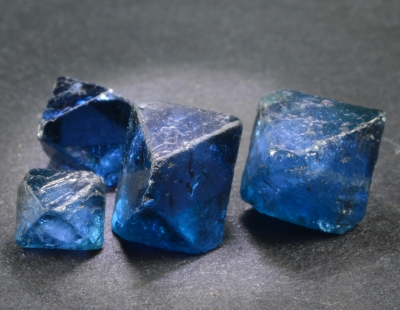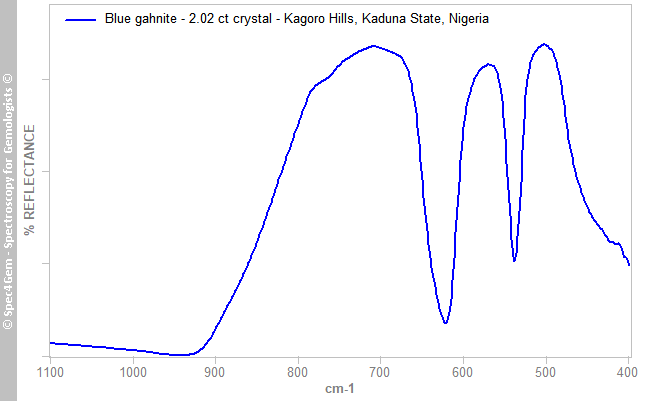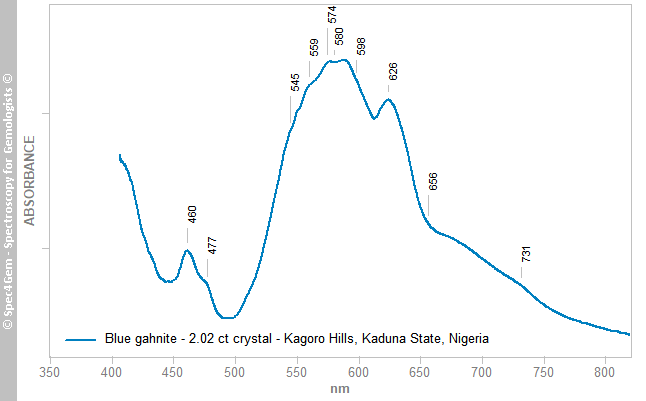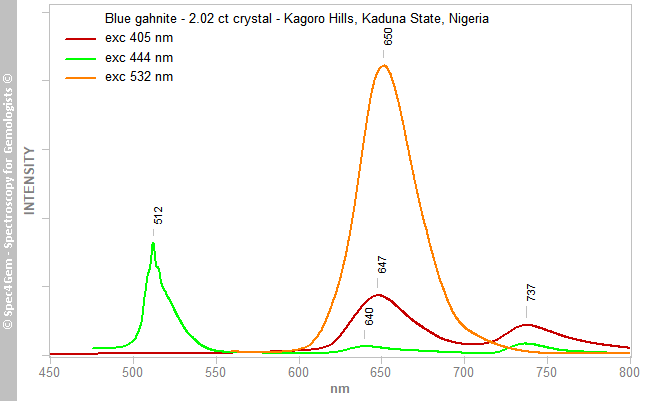Blue gahnite crystals from Kagoro Hills, Kaduna State, Nigeria
- Details
- Created: Saturday, 16 February 2019 19:27
During 2018, deep blue spinels from Nigeria were availble. The four crystals samples of this material were provided by the gemstone dealer Walter Asikaro directly from Nigeria and were described in this work. They are reportedly from the Kagoro hills located in the Kaduna state, north-central Nigeria. Gem quality gahnite from Jeema, also from Kaduna state was described in 1984[1] and 2018[2]. Nigeria is known for its sapphire deposits in Mambilla, Taraba State as well as for its zircon turning blue while heated from Antan in the Kaduna state.
The samples' crystals (figure 1) are well-formed octahedra with slightly corroded faces. They contain some tiny colorless inclusions looking like crystals, some which are bigger show prisms with square and some other with hexagonal sections but unidentified at the moment. Two octahedra crystal contain bigger red-brown to red crystals identified as sphalerite[12] (updated 2019-12).
 Figure 1. The blue gahnite from Kagoro hills, Kaduna state, Nigeria,
Figure 1. The blue gahnite from Kagoro hills, Kaduna state, Nigeria,the foreground stones (left to right) weight 0.57, 2.02 and 2.07 ct, the
background stone weights 1.07 ct.
Octahedra crystals are not polished enough to read the RI with the gemological refractometer but the IR reflectivity meter gives a RI about 1.79, the Specific Gravity of each crystal is between 4.59 and 4.61, all stones together yield an average of 4.60. Both RI and SG are inconsistent with the spinel specie. Spinel belongs to the spinel isostructural subgroup (oxyspinel group, spinel supergroup according to IMA 2018) where 28 species are identified and only 6 with predominant Al with the formula (Y-Al2O4). The most commons ones are the spinel (commonly known in gemology) with Y=Mg, the hercynite with Y=Fe, the galaxite with Y=Mn and the gahnite with Y=Zn. Series exist between the corresponding end-members, and intermediate members have been found.
| Shape | octahedral crystal |
| Size | 4.6 to 7.3 mm |
| Color | deep blue, sometime referenced to as cobalt-blue but too dark to be qualified as 'cobalt spinel' |
| Lustre | vitreous |
| Weight | 0.57, 1.07, 2.02, 2.07 |
| SG | 4.60 (all 4 stones together), individual SG following weight order : n.a., 4.61, 4.59, 4.60 |
| RI | ~1.79 approximative IR read with reflectivity meter (OTL for gemological refractometer et common liquid) |
| DR | n.a. |
| Pleochroism | none |
| Polariscope / Conoscope | isotropic but anomalous extinctions are observed in every crystal, the colorless inclusions are anisotropic |
| SWUV | inert |
| LWUV | inert |
| Magnetic susceptibility N52 | weak to moderate, each stone looses about 1/8 (12%) of its weight |
| Chelsea filter | red |
Table 1. Observational and measured properties
Infrared reflectance spectroscopy:
The infrared reflectance spectrum (figure 2) was collected from a face of the 2.02 ct crystal, spectra were also collected from other crystals but all yielded the same spectrum pattern. The spectrum's pattern is consistent with oxydes' spectra and shows some similarities to the spinel ones (see spinel database) but the 400-600 cm-1 range shows significant differences with two distinctive bands at 500 and 565 cm-1 which characterizes the crystal as gahnite, the Zn isostructural spinel (see gahnite database, Green gahnite from Brazil and Chukanov's book[3]).
 Figure 2. The IR reflectance spectrum of the 2.02ct octahedral crystal characterizes it as gahnite, the Zn isostructural spinel.
Figure 2. The IR reflectance spectrum of the 2.02ct octahedral crystal characterizes it as gahnite, the Zn isostructural spinel.UV-VIS-NIR spectroscopy:
The Vis spectrum (figure 3) was collected from the 2.02 ct crystal, the light path going through the crystal between two opposite and parallel faces. The absorption band wavelengths were calculated by gaussian fitting. The spectrum's pattern consists in a transmission window in the blue delimited by an edge below 400 nm and a wide group of bands between 530 and 650 nm. In the middle of the transmission window, there are two additionnal bands at 460 and 477 nm, respectively ascribed to Fe3+ and Fe2+. The edge in the violet is likely caused by an Fe2+ band superimposed to a wing of a large O2--Fe2/3+ LMCT band in the ultra-violet. Between 530 and 650 nm, the bands at 545, 580 and 626 nm are ascribed to d-d spin-allowed transitions 4A2(F) → 4T1(P) of tetrahedrally coordinated Co2+, and that at 559, 574 and 598 nm are ascribed to spin-forbidden transitions 5E → 3T2 of tetrahedrally coordinated Fe2+. The band at 656 nm and 731 nm are ascribed to mechanisms involving Fe2+/3+ pairs (IVCT and ECP). There is another wide band at 925 nm which is not displayed in figure 3 that is ascribed to the spin-allowed transitions 5T2g → 5Eg of Fe2+.
Bands' assignment in spinel has been studied for years, cobalt spectra[4],[5],[6] are well known by gemologist even using a handheld spectroscope and are easily observable with Verneuil sky-blue spinel, however spectra become more complex as soon as iron and even manganese and chromium interplay. Works on the subject were published by Taran et al. 2009[7], D'Ippolito et al. 2013[8], 2015[9] and were used for Fe2+ assignments.
This spectrum's pattern is well-known amongst the blue spinels colored by cobalt and iron (spinel database).
 Figure 3. The Vis spectrum of the 2.02ct octohedral crystal shows a transmission window centered around 470 nm giving the stone its blue color. The bands at 460 and 477 nm are respectively ascribed to Fe3+ and Fe2+, the bands at 559, 574 and 598 nm are ascribed to Fe2+, the bands at 656 and 731 nm are related to Fe2+/Fe3+ pairs and the prominent bands at 545, 580, and 626 nm are ascribed to Co2+ that plays the major role in the color.
Figure 3. The Vis spectrum of the 2.02ct octohedral crystal shows a transmission window centered around 470 nm giving the stone its blue color. The bands at 460 and 477 nm are respectively ascribed to Fe3+ and Fe2+, the bands at 559, 574 and 598 nm are ascribed to Fe2+, the bands at 656 and 731 nm are related to Fe2+/Fe3+ pairs and the prominent bands at 545, 580, and 626 nm are ascribed to Co2+ that plays the major role in the color. The on-going topic with blue spinels is to know if such spinel is a cobalt-spinel in comparison to the Luc-Yen spinel ?
During 2018, Palke et Sun (GIA) stated that cobalt, even at low concentration, gives the blue color to spinel although iron which is usually more abundant, and according to its concentration, modifies the darkness of the stone or makes it grayish. Therefore, a cobalt-spinel, is a spinel colored by cobalt with a vivid blue color, darker spinels cannot be qualified as cobalt spinel.
The gahnite from Nigeria is mainly colored by cobalt but because of iron, its color does not qualify for cobalt-spinel color even if attractive.
Photoluminescence spectroscopy:
The photoluminescence spectra (figure 4) of the 2.02 ct octahedral crystal were collected for three excitation sources: 405, 444 and 532 nm. The 405 nm laser excited a weak luminescence at 647 and 737 nm, and none around 690 nm as it could be expected for Cr3+ in the red as for many spinels. The 444 nm laser excited a weak green luminescence at 512 nm and two very weak band at 640 and 737 nm. The 532 nm laser excited a moderate orange-red luminescence peaking at 650 nm.
The emissions at 512 and 737 nm are connected to Mn2+ [11]. The emission at 650 nm while excited at 532 nm is ascribed to Co2+, the excitation falls in the vicinity of the 4T1(P). With the 405 and 444 nm excitations, the emissions are respectively at 647 and 640 nm but comparatively much weaker than that for 532 nm excitation, they are possibly connected to Co2+ as well.
The observed luminescences are similar to that of cobalt-bearing blue spinel (see spinel database).
 Figure 4. The photoluminescence spectra of the 2.02 ct octahedra crystal show Mn2+ luminescence at 512 nm and possibly at 737 nm, Co2+ luminescence at 640, 647 and 650 nm.
Figure 4. The photoluminescence spectra of the 2.02 ct octahedra crystal show Mn2+ luminescence at 512 nm and possibly at 737 nm, Co2+ luminescence at 640, 647 and 650 nm.Conclusion:
The IR reflectance spectroscopy identifies the octahedral crystals as gahnite the Zn isostructural spinel. The blue color mainly results of Co2+ and secondarily of Fe2+/Fe3+ but as iron absorbs a part of the blue at 460 and 477 nm, it likely causes the 'dark' blue color. The dark-blue color cannot qualify for the cobalt spinel color which is a bright, vivid blue color. The photoluminescence spectroscopy confirms the presence of Co2+ and Mn2+ but Cr3+ is not 'detected'.
Post study updates:
- Fall 2019, GIA published in the Gems News International section of the Gems & Gemology journal[12] a note about this material:
- the red/brown inclusions were identified as sphalerite by Raman spectroscopy,
- the SG (4.180-4.294) is far different of that measured on the samples of the present work which is 4.60. - December 2019, in the article "Blue Ghanospinel crystals from Nigeria" published in Gemmology Today[13]:
- the SG is given for 4.50.
[1] Gem quality gahnite from Nigeria, B. Jackson, Journal of Gemmology, 1982, Vol. 18, No.4, pp. 265–276
[2] Blue Gahnite from Nigeria, E. Boehm, B.M. Laurs, Journal of Gemmology, 2018, Vol. 36, No.2, pp. 96-97
[3] Infrared spectra of mineral species, Nikita V. Chukanov, 2014, Springer Editor, ISBN: 978-94-007-7128-4
[4] 'Cobalt-blue' Gem Spinels, J.E. Shigley, C.M. Stockton, Gems & Gemology, 1984, Spring, pp. 34-41
[5] Cobalt colored Color-Change Spinel, P. Maddisson, Gems & Gemology, 1990, Fall, pp. 226-227
[6] Cobalt-colored synthetic spinel, GRC, Gems & Gemology, 1991, Summer, pp. 113-114
[7] Optical spectroscopic study of tetrahedrally coordinated Co2+ in natural spinel and staurolite at different temperatures and pressures, M.N. Taran, M. Koch-Müller, A. Feenstra, American Mineralogist, 2009, volume 94, pp. 1647-1652
[8] Crystallographic and spectroscopic characterization of a natural Zn-rich spinel approaching the endmember gahnite (ZnAl2O4) composition , V. D'Ippolito et al., Mineralogical Magazine, 2013, Vol. 77, pp. 2941-2953
[9] Color mechanisms in spinel: cobalt and iron interplay for the blue color, V. D'Ippolito et al., Phys Chem Minerals, 2015, Vol. 42, pp. 431-439
[10] What Is Cobalt Spinel? Unraveling the Causes of Color in Blue Spinels, A.C. Palke, Z. Sun, Gems & Gemology, 2018, Fall, p. 262
[11] Luminescent Spectra of Minerals, Boris S. Gorobets and Alexandre A. Rogojine, Moscow, 2002, ISBN: 5901837053, p. 175
[12] Blue gahnite from Nigeria, M. Hain, Z. Sun, Gems & Gemology, 2019, Fall, pp. 434-436
[13] Blue Gahnospinel crystals from Nigeria, J.M. Arlabosse, Gemmology Today, 2019, December, pp. 5-8

